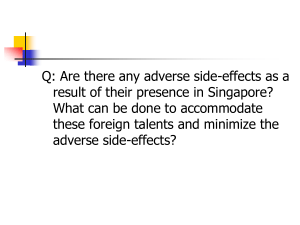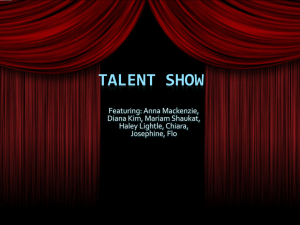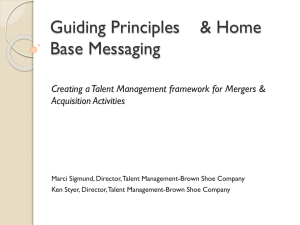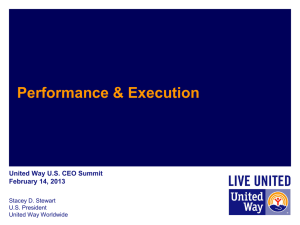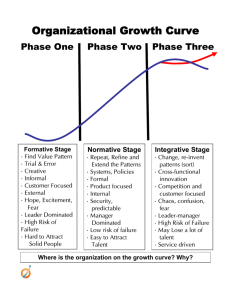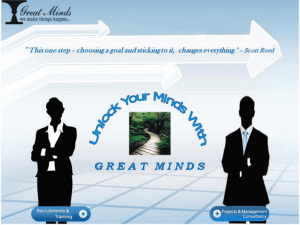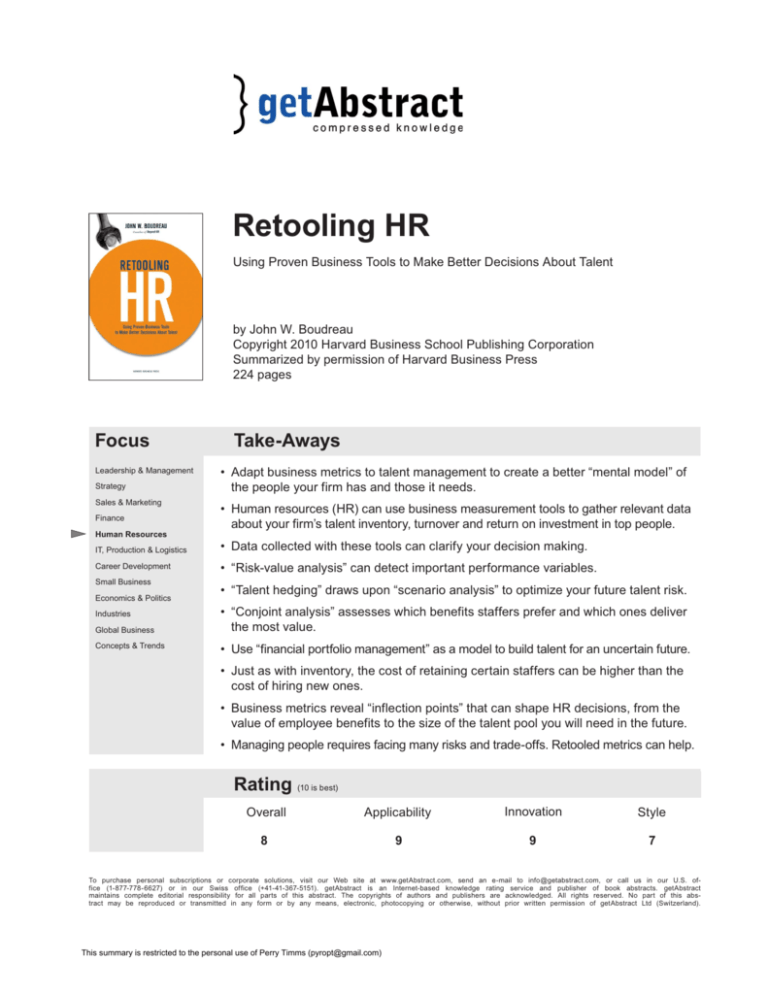
Retooling HR
Using Proven Business Tools to Make Better Decisions About Talent
by John W. Boudreau
Copyright 2010 Harvard Business School Publishing Corporation
Summarized by permission of Harvard Business Press
224 pages
Focus
Leadership & Management
Strategy
Sales & Marketing
Finance
Human Resources
Take-Aways
• Adapt business metrics to talent management to create a better “mental model” of
the people your firm has and those it needs.
• Human resources (HR) can use business measurement tools to gather relevant data
about your firm’s talent inventory, turnover and return on investment in top people.
IT, Production & Logistics
• Data collected with these tools can clarify your decision making.
Career Development
• “Risk-value analysis” can detect important performance variables.
Small Business
Economics & Politics
Industries
Global Business
Concepts & Trends
• “Talent hedging” draws upon “scenario analysis” to optimize your future talent risk.
• “Conjoint analysis” assesses which benefits staffers prefer and which ones deliver
the most value.
• Use “financial portfolio management” as a model to build talent for an uncertain future.
• Just as with inventory, the cost of retaining certain staffers can be higher than the
cost of hiring new ones.
• Business metrics reveal “inflection points” that can shape HR decisions, from the
value of employee benefits to the size of the talent pool you will need in the future.
• Managing people requires facing many risks and trade-offs. Retooled metrics can help.
Rating (10 is best)
Overall
Applicability
Innovation
Style
8
9
9
7
To purchase personal subscriptions or corporate solutions, visit our Web site at www.getAbstract.com, send an e-mail to info@getabstract.com, or call us in our U.S. office (1-877-778-6627) or in our Swiss office (+41-41-367-5151). getAbstract is an Internet-based knowledge rating service and publisher of book abstracts. getAbstract
maintains complete editorial responsibility for all parts of this abstract. The copyrights of authors and publishers are acknowledged. All rights reserved. No part of this abstract may be reproduced or transmitted in any form or by any means, electronic, photocopying or otherwise, without prior written permission of getAbstract Ltd (Switzerland).
This summary is restricted to the personal use of Perry Timms (pyropt@gmail.com)
[LoginContext cu:1039405 asp:2073 aff:2109 lo: en co:GB] 2012-11-12 07:38:02 CET
Relevance
What You Will Learn
In this Abstract, you will learn: 1) How to use business tools from outside human
resources to make personnel decisions, 2) How to use scenario planning to strategize
future talent needs, and 3) How to manage your talent inventory and “talent life cycles.”
Recommendation
Professor John W. Boudreau wants you to rethink the contribution your human resources
unit makes to the way your company recruits, develops and retains crucial “talent,” that
is, people. Dodging most, but not all, jargon, Boudreau advocates using metrics from
the business side of your organization to evaluate how talent contributes to your firm
and how your talent needs will vary under changing business conditions. He asks you to
examine how you will muster enough people with crucial skills, now and in the future,
and suggests strategically rethinking your workforce and considering how to develop it
as the demand for pivotal skills spikes or shrinks. Boudreau makes his points with sharp
intelligence in this clearly written, well thought-out book. It covers some very specific
subject areas pertinent to HR professionals, but it is not a difficult read, partly due to
its lively examples. While HR professionals who want to play a more strategic role will
receive it most readily, getAbstract finds that this book will also help talent-focused
C-level and middle managers who want more from HR and their employees. Boudreau
makes a solid case for the merit of good metrics, but he’s aware that HR is measuring
people, not widgets, so risks and trade-offs abound.
Abstract
“When decisions
about human
capital are recast
in the language
and logic of
proven business
frameworks,
leaders outside
of HR can…be
held accountable
[for] their human
capital decisions.”
“The work that
leaders do when
it comes to
talent decisions
and processes is
valuable, so why is
HR still struggling
with its identity
after over 50 years
of progress?”
Identify and Retain Your Best Talent
Just as the 2008 financial crisis was setting in, Jack Welch, former CEO of General
Electric, advised companies to set aside a “bucket of money” to retain their best
performers. He explained that increased competition during hard times makes top talent
even more important. If your best employees become disillusioned, they will be more
likely to take offers from your competitors or to seek new opportunities. Few executives
listening to Welch had a retention fund. They were not even sure what metrics to use
to determine which staffers were the most crucial to retain. No company would be that
casual about its products, its logistics or its finances.
Human resources (HR) needs a stronger “mental model” of how talent is distributed in
a firm and what value each person adds. To begin, HR can “retool” the way it measures
and communicates employees’ contributions in real terms. Then it can use the results
to help non-HR managers understand and communicate about staffing issues. Since HR
systems aren’t usually geared for cross-silo partnering, retooling HR in this way helps
you rethink and re-engineer your HR and business metrics to garner relevant data about
your talent inventory, turnover and return on your personnel investment.
Some employees provide a bigger bang for the company’s buck than others. Using
proven logic from engineering, HR can assess how each person and position contributes
to corporate results. It can study how much return the firm would gain from reducing
process variations or improving results in specific positions. These indicators capture
“inflection points” at which “performance value levels off or accelerates.” Calculating
Retooling HR
© Copyright 2010 getAbstract
2 of 5
This summary is restricted to the personal use of Perry Timms (pyropt@gmail.com)
[LoginContext cu:1039405 asp:2073 aff:2109 lo: en co:GB] 2012-11-12 07:38:02 CET
“A central premise
of this book is the
need to confront
uncertainty by
applying the logic
of well-developed
frameworks to
talent dilemmas.”
“Another
advantage of
seeking out allies
in other functions
is that those
experts can help
HR leaders be
smarter about the
proven business
models that
support those
functions.”
“Retooling invites
HR leaders and
stakeholders
to embrace the
underlying logic of
other disciplines
and apply it to vital
decisions about
human capital.”
“The optimization
choices suggested
by retooled HR
departments will
always be tempered
by the reactions
and responses of
the real people they
affect.”
“return on improved performance” (ROIP) gives HR a basis for understanding that tradeoff and making decisions about personnel.
How Boeing Used Analytical Tools
Boeing’s development of its new 787 Dreamliner aircraft required overcoming massive
technical, supply chain and talent resource problems. Its engineers’ role was critical. The
Boeing case shows how three frameworks used in engineering can reveal opportunities
in talent management:
1. “Kano analysis” – This tool charts how improved performance creates value. At
Boeing, improving engineers’ performance with suppliers added more value than
improving their technical engineering performance.
2. “Risk-value analysis” – This tool identifies where performance risk is most
significant. For Boeing, it showed that avoiding the risk of poor designs was key, but
that taking a risk on better supplier management was also key.
3. “Constraint or bottleneck analysis” – This tool from operations reveals that
while engineering is important, the strategic bottleneck for Boeing was in its
supply chain talent.
These tools have long helped engineers determine where to invest in improved
performance, and they can do the same for HR leaders investing in improved employee
performance.These tools can reveal when it is dangerous to copy “best practices,” and
where you must compete differently. These metrics can indicate which employees you
need and what training to give them. McDonald’s found that it could use a call center to
relay drive-up orders electronically, because drivers often ask for menu items by number
(“number three with a Coke”) and don’t interact with staffers. In contrast, Starbucks
needs well-trained baristas because their chats with customers are intrinsic to its coffee
shops’ ambience. McDonald’s “counter associates” also need to learn to work with
patrons, but the engineering logic of performance-risk and Kano analysis shows that
Starbucks should take more risks than McDonald’s.
Adapting business metrics allows HR to “invest in performance management,
work analysis and competency systems”; monitor systems’ effectiveness; improve
performance management to handle risk and return; and analyze the risk of shoddy
work. HR should use the 80-20 rule and pay attention to “the 20% of performance that
makes 80% of the difference.”
Mitigating Organizational Risk with “Talent Hedging”
Every business faces hazards, but firms can master and exploit certain risks. When
Michael Jackson became CEO of AutoNation in 2001, he assessed its range of risks,
analyzing how it could thrive under various scenarios. What if North American auto
sales dropped from 17 million cars sold per year to 10 million? What if a credit crunch
occurred? The firm’s leaders considered many scenarios and made choices focused
on the highest expected returns. “Talent risks” parallel financial risks, like the ones
AutoNation faced, and the same tools can help organizations build talent portfolios that
optimize risk in uncertain situations. Consider your talent needs now and under different
scenarios. Just as with a financial portfolio, inflection points across future scenarios
define “when to invest in talent to prepare for one future, multiple futures” or a “generic”
future. Your purpose is not to predict the future, but to consider its possibilities and risks.
Then define “your best investment in people.” Once you see how your talent needs could
change and what various scenarios could demand, conduct a “gap analysis” to see what
Retooling HR
© Copyright 2010 getAbstract
3 of 5
This summary is restricted to the personal use of Perry Timms (pyropt@gmail.com)
[LoginContext cu:1039405 asp:2073 aff:2109 lo: en co:GB] 2012-11-12 07:38:02 CET
“Strategic
workforce planning
can tap great
value as a tool
for considering
multiple futures
and designing
the optimum
talent mix to meet
them.”
“Invest in
targeted research
to precisely
understand the
preferences and
behaviors of key
talent segments.”
“Data on
turnover patterns
has untapped
potential to help
leaders improve
some of their
most important
workforce decisions
if the data is
embedded in the
right framework.”
“Risk and
uncertainty
about human
capital are facts
of organizational
life.”
skills are available, and where you are over- or under-supplied. Use risk-analysis tools to
determine where to reduce the gaps. The right decision may be to use portfolio theory
to build talent for several different future situations. Build flexibility in. As Ron Parker,
Pepsi’s executive vice president for HR, explains, “You cannot stay in a steady state in
a competitive global environment.” Instead, he says, ask, “How and what do I need to
change to keep up with the future?”
Talent hedging – creating a talent portfolio optimized for a range of possible future
conditions – gives you the same advantages that a well-crafted financial portfolio provides
investors. This includes “diversifying” talent in the way that investors diversify their
stocks. You will face a talent inflection point where “employee shortages or surpluses
become strategically valuable.” Merely extrapolating the future from the past or present
may seem safe, but the future is often surprising. Low-probability events do occur, and
likely events often don’t happen. To prepare, link your “talent supply planning” with
your “strategic scenarios,” diversify your staff, hedge your investment in personnel and
collect the right data to monitor your progress.
Which Benefits and Perks Provide the Biggest Return?
The tools your organization uses to understand how customer segments and preferences
drive business value can also be applied to understand how employee segments and
preferences drive business value. Some companies create an employment brand to draw
desired recruits. Others provide a range of offerings and let workers select the choices
that interest them most. HR systems often already contain useful data, such as the way
staffers choose and use their benefits. The challenge is to know when to customize your
offering and when not to, just as with your products. Retooling your employment brand
strategy using marketing tools helps you track these patterns according to demographics
and geography. Do some benefits work better in certain locations? What do younger or
older employees want? Do preferences shift among personnel at various sites, and can
you accommodate such regional trends? Are you achieving lower turnover, particularly
among the critical people you must retain to remain competitive?
Marketing departments use “conjoint analysis” to study customers, define audience
clusters and determine clients’ preferences. Apply this tool to “talent segmentation” to
identify the traits of sets of workers, learn each group’s potential “impact” on earnings,
achieve good communication with each group, assess its responsiveness and ask if your
steps to meet each segment’s needs are effective and align with your firm’s goals. Using
conjoint analysis enables HR to find the correct mix of offerings to suit different workers.
Conjoint analysis goes beyond just asking staffers what they want; it reveals whether
they prefer some combination of customized benefit packages. Your goal is to create an
efficient menu of perks – to borrow a tool from marketing – that yields the biggest return
on your expenditures in recruiting, keeping and developing talent.
Managing Your “Talent Inventory” for Optimal Return
Companies keep enough raw materials on hand for smooth production, but not so much
that they tie up funds in inventory that sits in a warehouse. However, all inventory items
are not equal. Some parts are so critical that a shortage would devastate production.
Some require long acquisition lead times, while other parts – or substitutes for them
– are readily available. This logic can help you retool how you optimize your workforce.
Some talent is difficult to acquire, so develop people who can step into hard-to-fill roles
or build up leads so you can recruit pre-qualified candidates. If a skill is critical, you may
want to have more people on hand with that talent than you immediately need.
Retooling HR
© Copyright 2010 getAbstract
4 of 5
This summary is restricted to the personal use of Perry Timms (pyropt@gmail.com)
[LoginContext cu:1039405 asp:2073 aff:2109 lo: en co:GB] 2012-11-12 07:38:02 CET
“Consider not
only ‘how do
we minimize or
reduce risk in our
human capital’
but ‘how do we
more deeply learn
to understand
human capital
risk…and reward
organization
leaders for taking
the right risks
and managing
the uncertainties
well’.”
“Unlike your
inanimate
inventories, the
people who make
up your workforce
inventory make
their own decisions
about where they
stay, when they
move, and what
they demand or
require.”
“People...are
not simply cogs
in a wheel, units
of inventory,
investment
vehicles or logistics
variables.”
Use “turnover analysis” to determine which departures are not a problem, and which
are. You can often “parse turnover rates” to reveal departing employees’ departments,
“tenure,” “performance” and “demographics.” Sometimes, the cost of retaining certain
staffers is higher than the cost of hiring new ones. In other cases, the exit of crucial
people means losing valuable knowledge and expertise. Identify pivotal personnel and,
as Welch said, set aside funding to keep them. Be aware of how your workforce needs
are changing as your company changes. Adapt your talent pool to what your organization
is becoming, rather than reacting to change after the fact. Train supervisors so you can
hold them accountable for their personnel decisions and for managing talent to avoid
unwanted turnover and personnel shortages or surpluses. As with inventory, you can
move beyond just filling requisitions and truly optimize your talent supply chain.
“Optimized HR”
As you pull all these concerns together, consider your employees’ life cycle through
“attraction, joining, developing, moving, engaging, performing and separating” from
your company. Just as manufacturing is a system that uses interacting processes to create
value, your whole workforce is a network of interacting talent. Staffing, training and
other HR systems work a lot like materials acquisition, manufacturing and shipping.
IBM recast its global workforce system using the same tools it used for its supply chain,
allowing it to better optimize its workforce risks, cost and returns.
Apply the model of “supply chain analysis” to employees’ processes and performance to
avoid underusing talent due to choke points and constraints. Direct your talent flow to
support your strategy. Track how your teams work together and which instances of crossdepartment coordination create value. Sometimes improving an individual’s performance
can help your entire “talent pipeline,” but other times you may need to rethink the pipeline
itself to free up your staffers’ real abilities. Don’t let managers hoard talent they don’t use.
Give them incentives and accountability for developing the people they supervise and
reward them for supplying talent to other areas. Help them see the impact of their talentrelated actions. To boost workers’ satisfaction and, probably, lower your recruitment and
hiring costs, create more ways for employees to develop themselves.
Companies need to retool HR over time to use more productive metrics and fresh
managerial approaches that address the risk in talent supply. When HR uses business
tools that are familiar to non-HR managers, its insights and recommendations are more
convincing, utilitarian and understandable, and its interdepartmental dealings become
more cooperative and collaborative. In today’s business environment, talent decisions
are capital decisions that determine if your company has the capacity to perform well.
Given this perspective, HR has a lot to contribute to the bottom line, from work analysis
to talent scenarios, supply strategies and life cycle management. Retooling HR also
shows how you can value people for more than just the talents they use today and help
them appreciate their own abilities. By demonstrating that you understand individuals’
contributions, you will help them build their careers. When you invest in your employees,
they feel more respected and appreciated, and that is the right basis for creating a culture
of human value – the best reason to retool human resources.
About the Author
John W. Boudreau, professor and research director at the University of Southern
California Business School, has published widely on human capital in competitive advantage.
Retooling HR
© Copyright 2010 getAbstract
5 of 5
This summary is restricted to the personal use of Perry Timms (pyropt@gmail.com)
[LoginContext cu:1039405 asp:2073 aff:2109 lo: en co:GB] 2012-11-12 07:38:02 CET



